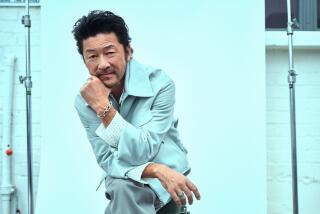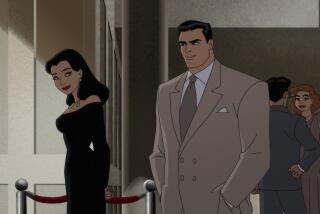Swept up in the ‘Samurai’ way
- Share via
In director Edward Zwick’s sweeping sentimental fiction “The Last Samurai,” the most modern of all screen stars, Tom Cruise, plays an embittered 1870s U.S. Army captain spiritually reborn by embracing the Way of the Samurai. Recruited by Japanese businessmen to help usher their country into its modern militaristic age, Cruise’s captain finds himself entranced by Japan’s romantic warrior caste, an infatuation that his director -- fully besotted by movie-made Japan -- enables by embracing the Way of the Hollywood Historical Epic.
Set shortly after the onset of the Meiji Restoration, when Japan threw off its feudal past and entered the modern age with a vengeance, “The Last Samurai” pivots on Cruise’s character, Nathan Algren, a veteran of his country’s war against the Indians. Haunted by visions of the Native American men, women and children he helped slaughter, Algren comes across as a sort of kinder, sorrier Reconstruction-era Lt. William Calley with excellent teeth and feathered hair, and a confessional impulse to record his intimate thoughts in occasional voice-over. Soaked in booze and bad memories, Algren has been unhappily shilling for the Winchester gun company when he agrees to travel to Japan in order to train the recently formed imperial army.
And so Algren lands in Japan amid a sea of new Western arrivals. Among the bowler hats and bespoke suits, he meets a British interpreter played by Timothy Spall, an actor who once dressed up in ceremonial Japanese drag to sing “The Mikado” in “Topsy-Turvy,” Mike Leigh’s film about Gilbert and Sullivan. Cruise’s captain doesn’t smear his face in white greasepaint and sport a knobby topknot, but he does go cinematically native not long after landing when he’s captured by a band of samurai rebels led by the dissident Lord Katsumoto. Brought to rousing life by Ken Watanabe, who enters on horseback and, by virtue of his imposing bearing and relative lack of dialogue, immediately gallops off with the film, Katsumoto remains faithful to the emperor but despairs at the changes that will put an end to his warrior class.
Movies tend to make a hash of history, and the best you can usually hope for is that the hash will be flavorful. “The Last Samurai” has as much to do with real 19th century Japan as “Gone With the Wind” has with real 19th century America, but there’s undeniable fun to be had from fantasies in which beauti- ful people run around propping up the illusion of the good old days. After Algren is brought back to Katsumoto’s paradisiacal village, the film shifts into a seductive lull that’s part captivity narrative, part touristic exposition. Denied booze, Algren slakes his thirst with this unknown culture, his attention divided between the erotic mystery of his hostess (played by a beauty named Koyuki) and the violent erotics of the samurai training. As the months melt away, so do Algren’s old ways and, lo, a samurai is born.
Taken on the level of spectacle rather than of sense, “The Last Samurai” affords the sort of fizzy enjoyment that can come with epic movie endeavors, including a meticulously detailed world unlike our own, an excellent supporting cast and some pulse-pounding fights. Watanabe’s no-nonsense believability makes for one dreamy marquee samurai, the kind that embodies the warrior’s romantic ideals without any of the thuggish unpleasantness. Zwick found loose inspiration for the character in Saigo Takamori, a lord who launched a rebellion against the government he helped create. The samurai lords who centralized Japan to shore the country up against the fast-encroaching West ended up doing more than just ridding themselves of the shogun leaders popularized by the likes of James Clavell and Richard Chamberlain; they effectively ensured their own irrelevancy.
Whether that’s a good thing or a bad thing remains a matter of debate and, as is often the case when it comes to historical interpretation, political persuasion. Still, it’s unnerving that Zwick either doesn’t get or can’t stomach that the way of the samurai led straight to the way of Japan’s imperial army in the 20th century. Given that “The Last Samurai” isn’t a documentary, perhaps that shouldn’t matter. And it wouldn’t if Zwick and co-writers John Logan and Marshall Herskovitz didn’t want to have their historical cake and eat it too. They design their film to look and sound realistic, but because the mythology of old Japan plays better (and easier) than its often grim, endlessly contradictory reality, the filmmakers also play fast and loose with the truth.
Other than confirming that movie samurai are cool and that he grooves on such boardroom-ready ideas as loyalty to one’s master, it’s unclear what Zwick means to say in this film. The nostalgia for a feudal past only works if you’re hanging with the powerful, while the suggestion that guns didn’t hit Japan until the 19th century smacks of misplaced wishful thinking. Zwick says he has long been hooked on movies such as Akira Kurosawa’s 1954 masterpiece “Seven Samurai,” but he seems to have forgotten that a few of Kurosawa’s 16th century fighters are in fact felled by gunfire. More difficult to ignore is the film’s fantasy that the fate of the samurai was in any way similar to that of Native Americans, a suggestion that is, to put it mildly, idiotic.
There’s a chance that all this would play better if Cruise didn’t seem radically out of place and time. Few stars throw themselves into their movies with such furious conviction, and Cruise certainly gives his physical all in his fight sequences. What he can’t do is go deep by himself. Not every director can push the actor off his pedestal into the muck of authentic feeling, as Paul Thomas Anderson did with “Magnolia” and Steven Spielberg did with “Minority Report,” and few screenwriters give him reason to try. It’s a measure of how short “The Last Samurai” falls that when Katsumoto asks Algren, “What do you want?” this pregnant question seems best answered by the sight of Cruise sliding across the floor in a kimono, provoking visions of his BVD dance in “Risky Business.”
Like “Dances With Wolves” and any number of romances, “The Last Samurai” centers on a white man plunged into an alien world. There’s no denying the tug of this sort of cultural immersion, which is played out daily in yoga studios across the country, and although Cruise fails to plumb the depths here, there’s pathos in his character’s anguish and spiritual hunger. Because action instead of reflection remains the name of the game in this crypto-western, however, the filmmakers put most of their emphasis on all of the exceedingly nifty ways you can swing a sword. That probably explains why, despite its exasperating flaws, I like the film as much as I do: There are all sorts of movie pleasures, but the truth is that for some of us a fighting man in a kimono can be awfully hard to resist.
*
‘The Last Samurai’
MPAA rating: R, for strong violence and battle sequences
Times guidelines: Some intense and bloody sword violence, some gunplay
Tom Cruise...Nathan Algren
Timothy Spall...Simon Graham
Ken Watanabe...Katsumoto
Billy Connolly...Zebulon Gant
Tony Goldwyn...Col. Bagley
Warner Bros. Pictures presents a Radar Pictures/Bedford Falls Company/Cruise-Wagner production, released by Warner Bros. Director Edward Zwick. Writers John Logan, Marshall Herskovitz, Zwick. Producers Zwick, Herskovitz, Tom Cruise, Paula Wagner, Scott Kroopf, Tom Engelman. Director of photography John Toll. Production designer Lilly Kilvert. Editors Steven Rosenblum, Victor du Bois. Music Hans Zimmer. Running time: 2 hours, 20 minutes. In English and Japanese, with English subtitles.
In general release.
More to Read
Only good movies
Get the Indie Focus newsletter, Mark Olsen's weekly guide to the world of cinema.
You may occasionally receive promotional content from the Los Angeles Times.










